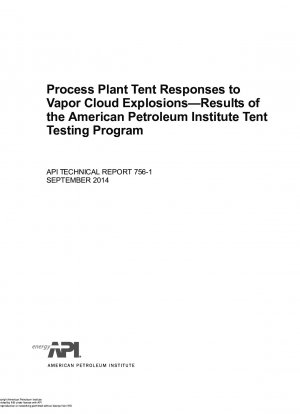API TR 756-1-2014
Process Plant Tent Responses to Vapor Cloud Explosions-Results of the American Petroleum Institute Tent Testing Program
- Standard No.
- API TR 756-1-2014
- Release Date
- 2014
- Published By
- API - American Petroleum Institute
- Latest
- API TR 756-1-2014
- Scope
- "INTRODUCTION AND BACKGROUND The American Petroleum Institute (API) contracted with Baker Engineering and Risk Consultants@ Inc. (BakerRisk) to perform vapor cloud explosion (VCE) tests to determine the response of tents to the potential explosion hazards that may be present at refineries@ petrochemical and chemical operations@ natural gas and other onshore process facilities covered by OSHA 29 CFR 1910.119. The testing was conducted to provide data for use by the API committee developing API Recommended Practice (RP) 756@ ""Management of Hazards Associated with Location of Process Plant Tents"". BakerRisk designed and constructed the Deflagration Load Generator (DLG) test rig used for these tests. The test rig measures 48 ft. long by 24 ft. deep by 12 ft. tall and has three rigid walls@ a rigid roof and floor@ and one open wall facing the structure being tested@ as shown in Figure 1. The interior of the rig is fitted with congestion. The test rig is filled with a propane/air mixture and ignited@ causing a VCE. The specific test environment is controlled through selection of fuel concentration@ obstacle geometry@ and the distance between the test article and the VCE test rig. The tests were deflagrations with moderate flame speeds such that the wave shape of the blast load would include a rise time to the peak pressure. This type of VCE is representative of typical accidental VCEs at industrial facilities. The VCE deflagrations are set to vent outside the test rig@ toward the test articles. The tents were placed at a sufficient range from the test rig such that three test articles could be tested simultaneously on each shot. The test rig was configured such that the blast loading on the tent could be changed by varying the fuel concentration rather than relocating the test articles. The tests were originally designed to serve multiple purposes: ?? Provide data on response of tents to a variety of blast loads ranging from 0.6 to 1.5 psi@ ?? Identify the failure modes for different types of tents@ and ?? Obtain data on tent response to support estimates on the vulnerability of tent occupants. As the testing was performed it became apparent that the tents being tested could withstand higher pressures than originally envisioned. The test program was therefore modified to accommodate the observed behavior. The development and modifications to the scope of the test program are discussed in Section 2 of this report. The following three series of tests were conducted. ?? A Series ?C Three types of non-wind rated tents were tested with the long side of the tents facing the blast source. The results of this series of tests are presented in Section 3. ?? B Series ?C The same types of tents were rotated 90 degrees and retested at higher loads. The results of this series of tests are presented in Section 4. ?? C Series ?C Three types of engineered tents (designed for 90 mph 3 second wind gusts) were tested at two different pressures. The results of this series of tests are presented in Section 5. Subsequent to the completion of the API funded tests BakerRisk performed two additional tests to evaluate the DLG performance as internal research. The response of the tents in these internal research tests@ including the response of contents added to the tents@ is discussed in Section 6. The Explosion Research Cooperative (ERC) participants voted to release the data from a series of shock tube tests performed under their sponsorship that addressed the potential for the contents of a tent to become airborne. The data@ in term of object mass and velocity@ are provided in Section 7. This report presents data only and does not provide any summary or conclusions on the acceptability of a tent siting approach."
API TR 756-1-2014 history
- 2014 API TR 756-1-2014 Process Plant Tent Responses to Vapor Cloud Explosions-Results of the American Petroleum Institute Tent Testing Program
